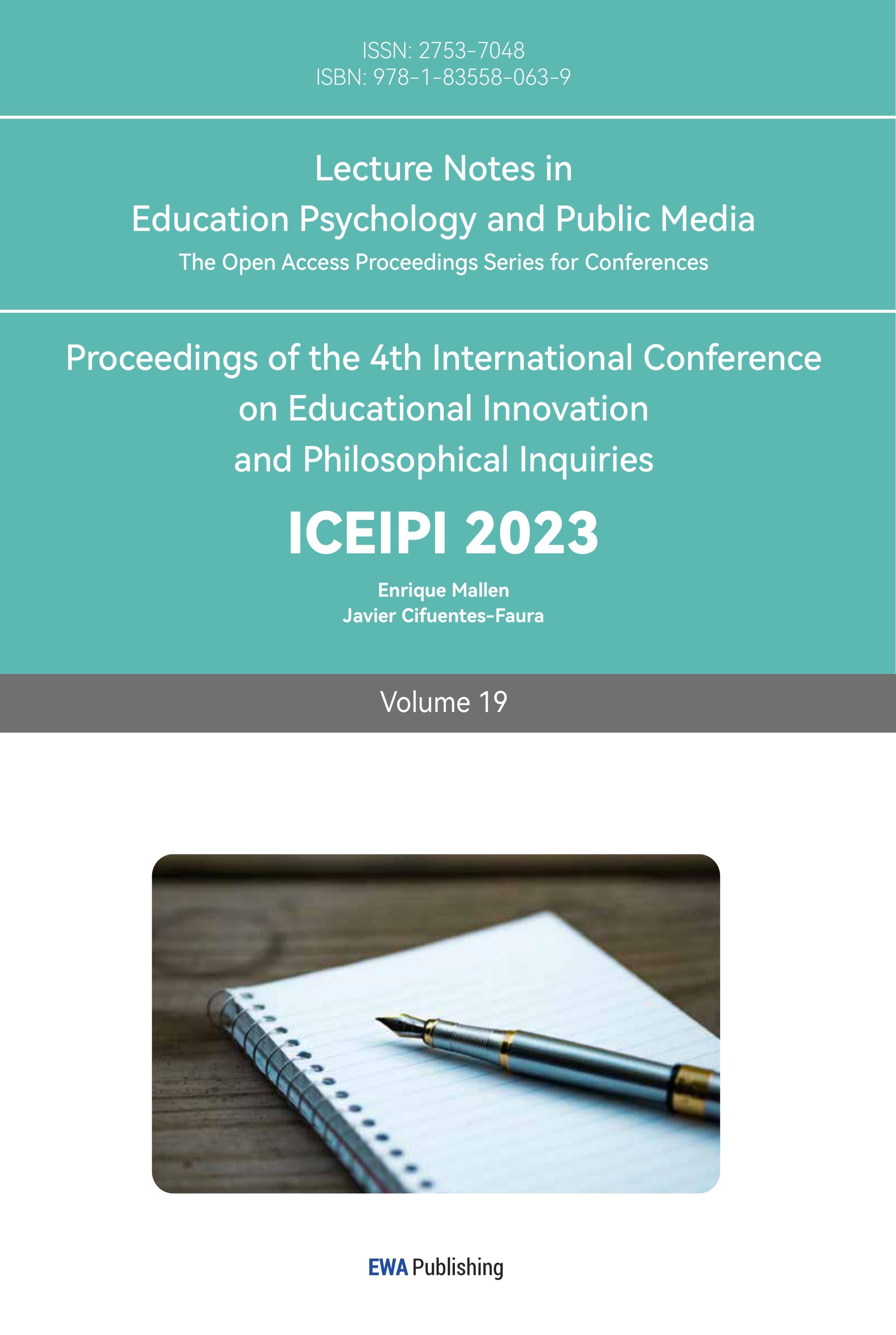References
[1]. Xiao, L. (2006). English Teaching Methodology. Beijing: Foreign Language Teaching and Research Press.
[2]. Ebe, A. E. (2010). Culturally Relevant Texts and Reading Assessment for English Language Learners. Reading Horizons: A Journal of Literacy and Language Arts, 50 (3). Retrieved from https://scholarworks.wmich.edu/reading_horizons/vol50/iss3/5
[3]. Vardell, S. M., Hadaway, N. L., & Young, T. A. (2006). Matching books and readers: Selecting literature for English learners. The Reading Teacher, 59(8), 734-741.
[4]. Suter, S. (2006). Meaningful differences in the everyday experience of young American children: Betty Hart and Todd R. Risley, Paul H. Brookes Publishing Co, Baltimore-London-Sidney, ISBN 1-55766-197-9.
[5]. Elley, W. B. (1996). Vocabulary acquisition from listening to stories. Reading Research Quarterly, 31(2), 174-193.
[6]. Goodman, Y. M. (1995). Miscue Analysis for Classroom Teachers: Some History and Some Procedures. Primary Voices K-6, 3(4), 2-9.
[7]. Nuttall, C. (1996). Teaching reading skills in a foreign language. Heinemann, 361 Hanover Street, Portsmouth, NH 03801-3912.
[8]. Greenberg, J. B. (1989, April). Funds of knowledge: Historical constitution, social distribution, and transmission. In annual meeting of the Society for Applied Anthropology, Santa Fe, NM.
[9]. Tapia, J. C. (1991). Cultural reproduction: Funds of knowledge as survival strategies in the Mexican-American community. The University of Arizona.
[10]. Vélez-lbáñez, C. G. (1988). Networks of exchange among Mexicans in the US and Mexico: Local level mediating responses to national and international transformations. Urban Anthropology and Studies of Cultural Systems and World Economic Development, 27-51.
[11]. Moll, L. C., Amanti, C., Neff, D., & Gonzalez, N. (1992). Funds of knowledge for teaching: Using a qualitative approach to connect homes and classrooms. Theory into practice, 31(2), 132-141.
Cite this article
Wang,Y. (2023). Analysis of the Methods for Selecting Children's English Materials. Lecture Notes in Education Psychology and Public Media,19,215-220.
Data availability
The datasets used and/or analyzed during the current study will be available from the authors upon reasonable request.
Disclaimer/Publisher's Note
The statements, opinions and data contained in all publications are solely those of the individual author(s) and contributor(s) and not of EWA Publishing and/or the editor(s). EWA Publishing and/or the editor(s) disclaim responsibility for any injury to people or property resulting from any ideas, methods, instructions or products referred to in the content.
About volume
Volume title: Proceedings of the 4th International Conference on Educational Innovation and Philosophical Inquiries
© 2024 by the author(s). Licensee EWA Publishing, Oxford, UK. This article is an open access article distributed under the terms and
conditions of the Creative Commons Attribution (CC BY) license. Authors who
publish this series agree to the following terms:
1. Authors retain copyright and grant the series right of first publication with the work simultaneously licensed under a Creative Commons
Attribution License that allows others to share the work with an acknowledgment of the work's authorship and initial publication in this
series.
2. Authors are able to enter into separate, additional contractual arrangements for the non-exclusive distribution of the series's published
version of the work (e.g., post it to an institutional repository or publish it in a book), with an acknowledgment of its initial
publication in this series.
3. Authors are permitted and encouraged to post their work online (e.g., in institutional repositories or on their website) prior to and
during the submission process, as it can lead to productive exchanges, as well as earlier and greater citation of published work (See
Open access policy for details).
References
[1]. Xiao, L. (2006). English Teaching Methodology. Beijing: Foreign Language Teaching and Research Press.
[2]. Ebe, A. E. (2010). Culturally Relevant Texts and Reading Assessment for English Language Learners. Reading Horizons: A Journal of Literacy and Language Arts, 50 (3). Retrieved from https://scholarworks.wmich.edu/reading_horizons/vol50/iss3/5
[3]. Vardell, S. M., Hadaway, N. L., & Young, T. A. (2006). Matching books and readers: Selecting literature for English learners. The Reading Teacher, 59(8), 734-741.
[4]. Suter, S. (2006). Meaningful differences in the everyday experience of young American children: Betty Hart and Todd R. Risley, Paul H. Brookes Publishing Co, Baltimore-London-Sidney, ISBN 1-55766-197-9.
[5]. Elley, W. B. (1996). Vocabulary acquisition from listening to stories. Reading Research Quarterly, 31(2), 174-193.
[6]. Goodman, Y. M. (1995). Miscue Analysis for Classroom Teachers: Some History and Some Procedures. Primary Voices K-6, 3(4), 2-9.
[7]. Nuttall, C. (1996). Teaching reading skills in a foreign language. Heinemann, 361 Hanover Street, Portsmouth, NH 03801-3912.
[8]. Greenberg, J. B. (1989, April). Funds of knowledge: Historical constitution, social distribution, and transmission. In annual meeting of the Society for Applied Anthropology, Santa Fe, NM.
[9]. Tapia, J. C. (1991). Cultural reproduction: Funds of knowledge as survival strategies in the Mexican-American community. The University of Arizona.
[10]. Vélez-lbáñez, C. G. (1988). Networks of exchange among Mexicans in the US and Mexico: Local level mediating responses to national and international transformations. Urban Anthropology and Studies of Cultural Systems and World Economic Development, 27-51.
[11]. Moll, L. C., Amanti, C., Neff, D., & Gonzalez, N. (1992). Funds of knowledge for teaching: Using a qualitative approach to connect homes and classrooms. Theory into practice, 31(2), 132-141.









